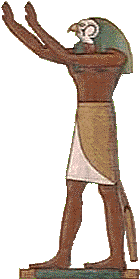

Strange 'twin' new worlds found
Perhaps they could be called Horus and Set. Since Egyptian Dieties were stellar in nature.
The Egyptian Heaven and Hell by E. A. Wallis Budge [1905] A journey through the night side of the Ancient Egyptian cosmos.
Vol II: The Book of Gates
Vol III: The Egyptian Heaven and Hell
The Book of Gates is an Ancient Egyptian cosmological treatise describing the architecture and inhabitants of the Tuat, the underworld which the boat of the Sun God, Ra, traverses during the night hours. This is the second volume of the three volume Budge series which deals with the books of the Underworld, the Egyptian Heaven and Hell. It also includes a short summary of the Book of Am-Tuat, the longer version of which comprises the first volume.
The Terrible Twins Horus and Set were originally expressions of the primal duality, the two aspects of Heaven, the day-sky and night-sky. As the Egyptian mythology was elaborated towards its final chaotic state, their symbolism drifted away from these absolute poles into the middle ground, first becoming solar, and finally taking on a variety of solar/martial and zodiacal characteristics. Yet their final form can still be expressed in a concise symbology, that of the astrological signs of Aries and Scorpio. Taken whole, their symbolism is that of the primal duality manifesting in its male aspects.
Math is Fun On a material world basis, Fractions are located between one and zero. For Ancient Egyptians, fractions had a religious origin from the myth of Horus and Seth. Seth tore out one of Horus' falcon eyes and cut it into pieces-pieces which thereafter symbolized certain fractions. Africans went on to develop a complex method of factorization. To show how conflict has occurred by mixing the spiritual with the worldly, European Renaissance scientist, along with their followers of Set (Satan), destroyed the sacred science by introducing the Evil Number, Zero, in arithmetic to take the first place of Number One. References: Diop, Civilization p276; Seleem, Egyptian Book of Life p12.
The two Egyptian deities Set and Horus are two sides of the same coin. Horus is the external manifestation of the spirit of being while Set is the hidden god of the internal, representing Energy and Force. In the IInd Dynasty, when the Two Lands were unified, Khasekhemwy ruled in the names of both Horus and Set, trying to find a peaceful solution to the eventual Osirian takeover. Thus both symbols of Kingship, Horus and Set, became part of the attributes of the King. Set then became the strength or power of the King, as Horus became the vision or sight of the King.''
Contendings of Horus and SethThis is written on Papyrus Chester Beatty I in Thebes during the New Kingdom and the reign of Ramses V. Its´purpose is entertainment rather than religious instruction, and it is written in a humorous way. Most likely it goes further back as its´content builds upon earlier tales of the deities involved .The tale is long with many incidents and what follows here is a much shortened version.
Osiris, Isis, Horus, and Set
While Osiris subdued the world by gentleness and persuasion, by song and flute (which he invented) his son Horus from first to last was a warrior. Born to be the avenger of his father, he is said to have assumed the shape of a human-headed lion to gain advantage over Set. In this form he is the Sphinx -- Har-em-chu -- which is verily his image. He is also represented standing on a boat of serpentine form, with spear in hand, killing the serpent. His constant warfare with Set covers many facts, cosmical, spiritual and historical. In one aspect it is the struggle with the lower, personal nature and symbolizes the trials of adeptship; the fact that his triumphs are but temporary shows that his adeptship has to be regained in each new birth. The magnet was called the "bone of Horus" and iron, "the bone of Typhon," the latter being the rough Titanic power which opposes its force to the divine magnetic spirit trying to harmonize everything in nature. The dual nature of Horus is referred to in Chapter XVII of the Book of the Dead in these words: "It is Horus when he riseth up with a double head, whereof one beareth right and truth and the other wickedness" (Set). In Chapter CLXXVII he is "the blue-eyed" and "the red-eyed Horus," -- Set was always depicted red. In Chapter XXIX B, Horus is the Universal Ego; the deceased says: "My heart is with me, and it shall never come to pass that it shall be carried away.... I am Horus, the dweller in hearts, who is within the dweller in the body." In Chapter LXXVIII, The Chapter of Making the Transformation into the Divine Hawk, the deceased says: "And behold, when as yet Isis had not given birth to Horus, I had germinated, and had flourished, and I had become aged. (pre-existence) ... And I had risen up like the divine hawk, and Horus made for me a spiritual body (sahu) containing his own soul.... I, even I, am Horus, who dwelleth in the divine Khu (luminous form). I have gained power over his crown, I have gained power over his radiance, and I have travelled over the remote, illimitable parts of heaven... Horus is both the divine food and the sacrifice.... The gods labor for him, and they toil for him for millions of years." In later times the Pharaohs, by way of asserting (rightfully or otherwise) their divine nature, assumed the title "The Golden Horus," for according to Chapter LXXXIII of the Book of the Dead, Horus was one of those Illuminated Beings "who emitted light from his divine body," and "who never lie down in death."

Find blog posts, photos, events and more off-site about:
panets, stars, astronomy, astrophysics, science, mythology, magick, Egypt, Horus, Set, egyptology, gods, creation-myths
No comments:
Post a Comment